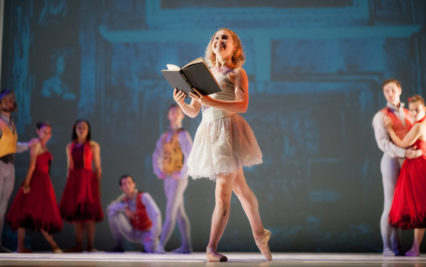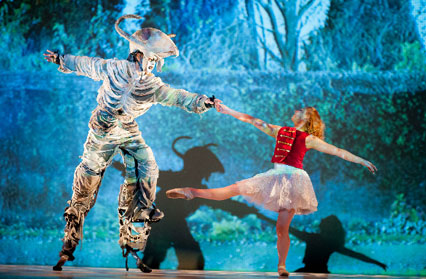Gary Raymond was at the Riverfront Theatre in Newport to review a performance of Beauty and the Beast by Ballet Cymru.

That the significance of ‘fairy tale’, with all of its pyscho-sexual and psycho-social subtexts, was the philosophical preoccupation of one of the twentieth century’s most interesting auteurs, Jean Cocteau, and also seems to be a preoccupation of Ballet Cymru should not be taken for granted. Their Beauty and the Beast is introduced not as an interpretation of the fairy tale per se, but rather as a work inspired by Coctaeu’s cinematic masterpiece from 1946, La Belle et la Bête. That Beauty and the Beast has become something of a signature production for Ballet Cymru says as much about the company’s fascination with the things that fascinated Cocteau as it does about this highly enjoyable, thought-provoking, if slightly flawed, production. And that is exactly where the most interesting question is to be asked about Ballet Cymru’s Beauty and the Beast: is there more going on in the production mounted or in the vision behind it?
Cocteau himself made his film openly stating that it was embarked upon to reverse the expectations of the audience in regards to reality and fantasy. The ‘human’ aspect would be formalised, and the fantasy would be realist. In the plot structures of fairy tale Cocteau could see a very modern path to a very important moral and anthropological statement:
My story would concern itself mainly with the unconscious obstinacy with which women pursue the same type of man, and expose the naiveté of the old fairy tales that would have us believe that this type reaches its ideal in conventional good looks. My aim would be to make the Beast so human, so sympathetic, so superior to men, that his transformation into Prince Charming would come as a terrible blow to Beauty, condemning her to a humdrum marriage and a future that I summed up in that last sentence of all fairy tales: ‘And they had many children.’
If this is the direction in which Ballet Cymru was headed – and it feels like it for a while – there is a distinct lack of a feeling of Beauty’s condemnation to a humdrum marriage. ‘A film must please at once, and we therefore have to devise ways to please and displease at the same time,’ Cocteau said. Here Ballet Cymru end up in no danger of a denouement that would have had a longer-lasting kick to it, but which might have displeased the audience.
Is there a suspicion here that Ballet Cymru are trying to have their cake and eat it? Are they talking Cocteau but giving you Disney?
The 1991 Oscar-winning Disney version of the story is heavily influenced by Cocteau’s film, too, and yet, like Ballet Cymru, cannot quite come to terms with the damning downbeat lesson at its heart. But that, ultimately, works entirely in Ballet Cymru’s favour, because what is actually presented here is not Cocteau, and not Disney, but Darius James’ version of the fairy tale. This is a Gothic romance, with flourishes of Freudian melodrama and a good dose of sturm und drang, in which true love will win out; and what better way to mount it all than with the most romantic of performance arts. And the melding of fairy tale to Ballet Cymru’s considerable strengths makes for a striking production that has quite rightly wooed audiences far and wide in the years since its conception.
This production had new blood, as well as some new innovations, and this new-look troupe filled the production with strong performances, suggesting Ballet Cymru has a strength in depth that perhaps outshines previous incarnations. To replace two of their most popular dancers in Emily Pimm Edwards (a born prima) and the irrepressible Daisuke Miura was never going to be an easy task, and Darius James and Amy Doughty have very wisely taken the opportunity to spread the responsibility. There is a suspicion that, as yet, the company still has a tendency to perform as a collection of individuals rather than as an ensemble (and some have been with Ballet Cymru for a while now), but there is much hope for the future with this collection of talent.
Lydia Arnoux, Ballet Cymru’s new prima, promoted from scene-stealing support to romantic lead, has stepped up with well-earned confidence to a position to which she might not have been stylistically suited. In this instance her diminutive stature enhanced her duets with the Beast who was easily twice her height on his costumed jump stilts – Arnoux’s beauty and physical vulnerability in the context of her developing relationship with the Beast is the perfect vessel for her inherent strength, both physical and emotional, to make themselves known as dramatic crises develop. Beauty has all the potential to be a powerful female figure, and Arnoux gets it exactly right. The disappointment here is that as an actor Arnoux comes into her own, but as a dancer she is not exploited to her potential. Next to her performances in The Tempest or Romeo and Juliet there is little for her to do, although she has so much more stage time. Each dance is clean and precise, but quite conventional. Arnoux has an explosive energy and talent, and here she is not given enough room to do her thing. One problem, although far from ‘twas Beauty killed the Beast’, is that the Beast is so cumbersome, so impaired by his stilts, he is as apt a partner for Arnoux as I would be after a Sunday dinner. Of course thematically, symbolically this works quite powerfully – the coming together of grace and gracelessness is part of the central idea – and Arnoux is perfect for the role (there is even a hint of the Josette Day about her). But man cannot be fed on symbolism alone, and there is an unevenness to exactly what the audience is getting – is this spectacle or literature?
Few productions in Wales will elicit such ponderousness, and it is testament to the continued thoughtfulness of the company that produces these fascinating and well-formed shows. Beauty and the Beast is a strong expertly crafted production that deserves all its plaudits. It may be holding back a little, David Wescott’s score may leave one feeling it never quite blossoms as it promises it might, but these are held up against some mighty plus points. To give dancers the role of the creeping, clawing woodland is a masterstroke and makes for a couple of marvellous set-pieces, and that the Beast is genuinely discomforting and, well, beast-like, is no small thing either. And Lydia Arnoux will have her day – it’s been coming for a while and she will soon be handed the role by Ballet Cymru that displays her considerable gifts most aptly.
Gary Raymond is a novelist, critic, editor and broadcaster.



 Enjoyed this article? Support our writers directly by buying them a coffee and clicking this link.
Enjoyed this article? Support our writers directly by buying them a coffee and clicking this link.








